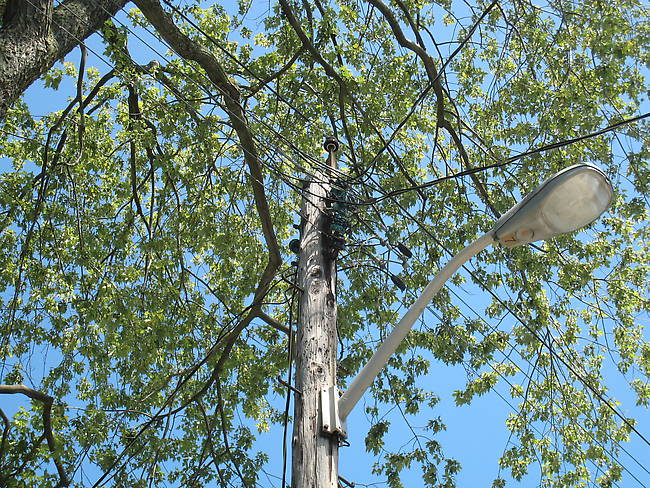
There are certain obscure back streets, I am sure, in almost every city of 100,000 or more located in North America (or any other part of the world), where vintage insulators, their obsolescence overlooked for sometimes over 100 years, can still be found doing what they do best - insulating wires. Up, on top of a pole, just shining in plain sight of anyone who passes by. The really sad part is that it is just us precious few in this hobby who really appreciate the history of seeing these things in the air. Looking skywards and spotting that precious, dirt-caked aqua glass, and being able to shake your head in wonderment at how that thing has remained in that spot, unbroken and unabandoned, for 80 years or more. While driving my girlfriend home just a couple weeks ago, a quick glance down a side street in one of the many outlying suburbs of London, Ontario, had my eyes fixated on aqua and clear glass adorning 3 and 4-pin brackets on either side of several, 'teens and '20s era low-voltage streetlight and power circuits. Frankly, I don't know much about the actual voltage or applications of these insulators, but I do know that London used to be absolutely covered in them. I have personally seen well over a thousand signal style insulators - 164s, 162s, 162.1s, 168s, etc - come out of use and wind up in either a dumpster, or, if I'm lucky, my hands. Whenever I see a side street with some still in the air, I get all uppity, and start trying to find the soonest time possible to get back and take some photos. I followed the scent of history, and found myself piloting a maze of vacant side streets, shaded by giant oaks, loving the sunny summer weather, and basking in the amazement of seeing all that old glass still up there. I was suddenly startled, upon turning at a certain side street, to see some slightly different insulators in use on the poles. What's this? These are cable styles! I was scrambling to make sense of why such higher-voltage insulators would be in use on a line where simple 164s or 162s would suffice. Perhaps the power company had a load of extra cable styles to use up. So there I was, staring blankly, and nearly "piloting" into parked cars, while my girlfriend screamed and tried to escape with her life. It was wonderful. The majority of the insulators on this one side street appeared to be Round drip Hemingray No. 62 CD 252s, and Canadian style light aqua No. 2 cables. I had only ever seen one Canadian style No. 2 cable in use before, and that would have been on a trolley line in downtown Toronto. It was nice to see them closer to home! Of course, my girlfriend was long gone by the time this photo was taken. I mean... she wasn't dead, I obviously came back another day when she wouldn't be so bored while I stumbled about taking pictures of the sky, much to the bemusement of everyone else, but to the embarrassment of us two. Yes, I parked the car this past Wednesday, another sunny, beautiful summer day in Ontario, and walked the street taking photos. Here is a glimpse of the first pole I encountered while driving down the street. The pole's contents (the closest side of it, anyways), from the top pin down, are as follows; 1.) CD 252, "Hemingray", No. 2 (or No.62) Cable, aqua 2.) CD 252, "No. 2 Cable", {Canadian Style}, light aqua 3.) CD 252, "No. 2 Cable", {Canadian Style}, light aqua 4.) Porcelain signal. Oh, and there looks to be a lone Hemingray - 20 CD 164 on the far side of the pole. What does [id=224014754;the next tantalizing pole] hold? |